Integral Hp AC motors Between 1-500 hp
The Energy Independence and Security Act of 2007 (EISA), which restates and broadens the definition of General Purpose Electric Motors, goes into effect on December 19, 2010. Certain motors "manufactured (alone or as a component of another piece of equipment)" will be required to have nominal full load efficiencies that meet the levels defined in NEMA MG-1 (2006) (see Table 12-12). Motors manufactured after December 19, 2010, must comply with the law.
For the first time, OEMs will be held accountable for the efficiency of motors in their equipment. With the deadline quickly approaching, motor manufacturers should have an action plan for complying with the law. They should be conducting testing in accordance with the regulations and carefully recording the results. OEMs requiring design changes should be reviewing their options. End users should be paying close attention to the amount of energy their motors consume, while researching potential cost saving programs available.
This new legislation, while vast in scope, is designed to "move the United States toward greater energy independence and security, to increase the production of clean renewable fuels, to increase the efficiency of products, buildings and vehicles, to promote research on and deploy greenhouse gas capture and storage options." Specifically, the new legislation restates the definition of General Purpose Electric Motors as defined in 10 CFR 431 from the Energy Policy and Conservation Act of 1992 (EPCA) and classifies these motors as Subtype I.
Additionally, the law also defines a new category of General Purpose Motors, Subtype II, as motors incorporating design elements of a general purpose motors (Subtype I) that are configured as:
- U-Frame motors
- Design C motors
- Close coupled pump motors
- Footless motors
- Vertical solid shaft normal thrust motor (tested in a horizontal configuration)
- Eight pole motors (900 rpm)
- Poly-phase motors with voltage less than 600 volts (e.g., 575 volts)
Subtype II motors between 1 and 200 hp manufactured alone or as part of another piece of equipment shall have a nominal full load efficiency that is not less than as defined in NEMA MG-1 (2006) (see Table 12-12). Each fire pump motor manufactured alone or as a piece of equipment must comply with Table 12-11. NEMA Design B motors with horsepower ratings above 200 hp and not greater than 500 hp are required to comply with NEMA MG-1 (see Table 12-11).
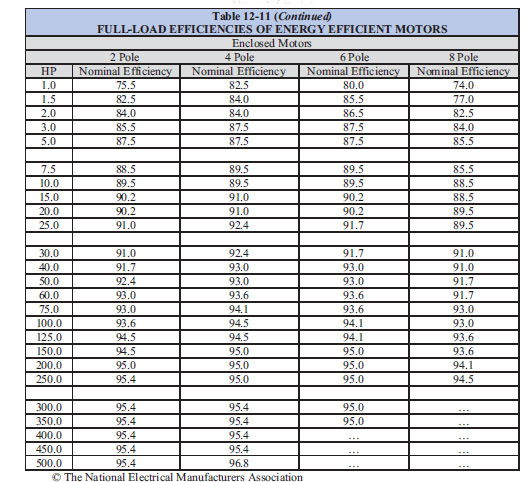
Subtype II motors must be manufactured to these efficiency levels beginning 12/19/2010.
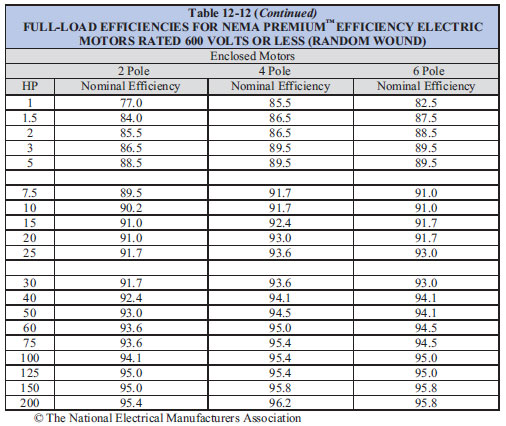
Subtype I Motors (1-200 hp) must be manufactured to these efficiency levels beginning 12/19/2010.
A significant point is that close coupled and footless motors, used extensively in pumping applications, will now be regulated for the first time ever under Sub Type II. Whether a pump OEM purchases motors from vendors or manufactures them for his own products, the efficiency level must be acceptable and a Certificate of Compliance from the Department of Energy (DOE) is required.
Impact on Pump Manufacturers (OEMs) that Employ Motors in Equipment
Electric Motors (EISA)
After December 19, 2010, covered motors cannot be manufactured alone or sold as a piece of new equipment below the prescribed levels of efficiency. Many OEMs purchase motors from manufacturers and may only have a few specifics to consider. Some already offer motors in their equipment that meet the regulations and market them as high-efficiency models in their product offerings. Some OEMs manufacture their own motors for equipment needs. No matter the circumstance, OEMs will most likely have to address the new regulations.
OEMs purchasing motors from manufacturers requiring increased efficiencies to meet the regulation may have new design considerations to consider. Motors meeting higher efficiencies tend to run faster than their less efficient counterparts. Matching speeds to application need (pump flow, fan cfm) is important to consider. Drives may be required, which offer the opportunity to increase system efficiency in applications with variable output requirements. In some cases, mounting dimensions for motor into machinery may be slightly different. If changes need to be made to meet the requirements, OEMs will have the opportunity to validate motors to find the best fit for their equipment needs based on performance and price.
OEMs manufacturing their own motors covered by EISA for their own equipment have more to consider. They must submit a Compliance Certificate (CC#) Application to the DOE to verify their motors are compliant. In this situation, the law views the OEM as the manufacturer and requires the same compliance as a motor manufacturer. Evidence must be presented, including test results from accredited labs or programs demonstrating motor designs meet requirements. The DOE will then issue a CC# that must be displayed on all covered motor nameplates. The OEM may choose to review motor suppliers selling covered products approved by DOE, or continue building motors. In either case, careful review is required by engineers and equipment designers. OEM purchasing departments are important in this process as motor suppliers need to be sourced and evaluated.
Impact on Pump Users
Electric Motors (EISA)
Electric motors are the single largest electric technology deployed in terms of energy use, which is why the DOE creates Minimum Efficiency Performance Standards (MEPS) in regulations like EISA. Electric motors convert an estimated 40 to 60 percent of all electricity generated in the world into mechanical energy. Electric energy used by motors in industrial and commercial facilities can be 70 percent of the total used. Countries around the world are following the United States' lead by creating MEPS programs.
The good news for end users at all levels is these regulations will result in reduced energy consumption if applied properly. End users have no direct compliance requirements with the DOE like motor manufacturers and OEMs. They do not need to concern themselves with equipment design issues related to motor changes nor do they need to submit compliance paperwork to the DOE.
The end users' best approach to realizing savings is a Motor Management Plan. Organizations succeeding with active motor management programs have dedicated staff consisting of management, engineers, maintenance and purchasing professionals focused on specific policies and goals. These organizations claim 5 to 8 percent reductions in their total electric energy use with increased process reliability as a result of their motor management programs.
Many resources are available to assist end users with realizing cost savings. At a minimum, end users should have a motor purchase specification that includes buying NEMA Premium® motors and a motor repair specification. With no regulation for efficiency associated with motor repair, working with a motor service center that has a quality assurance program is critical.
Another resource for motor management information is the Motor Decisions Matter (MDM) campaign, administered by the Consortium for Energy Efficiency, which includes motor manufacturers, utilities, the DOE and energy efficiency advocates. Utility organizations across the country offer demand side management programs that include financial incentives to upgrade motors and drives. A list of organizations with rebate programs can be found at the MDM.
Part Two of this article will address the Small Electric Motor laws being introduced later this year. The DOE estimates the Small Electric Motor laws will save 2.2 quads of cumulative energy during the 30 year period from 2015-2045.
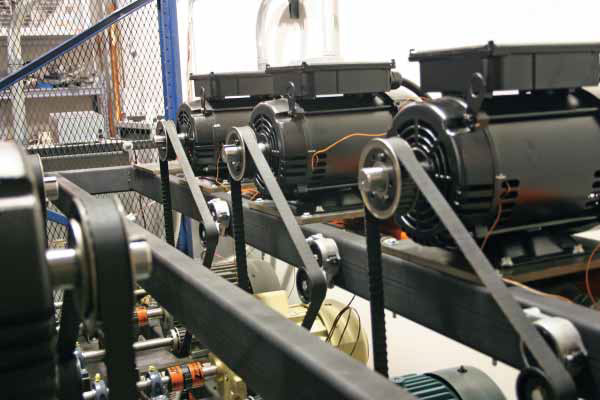
Motor reliability testing
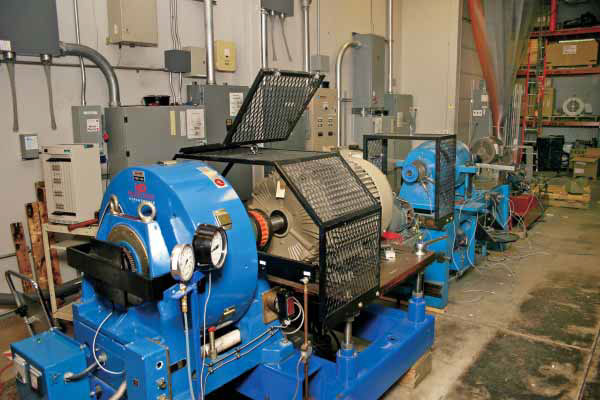
Dynamomter testing (efficiency)
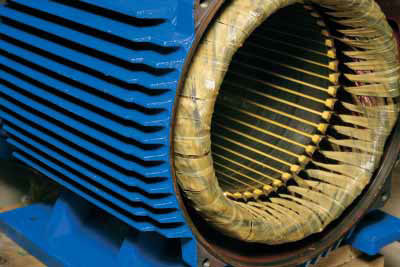
Motor build inspection analysis

